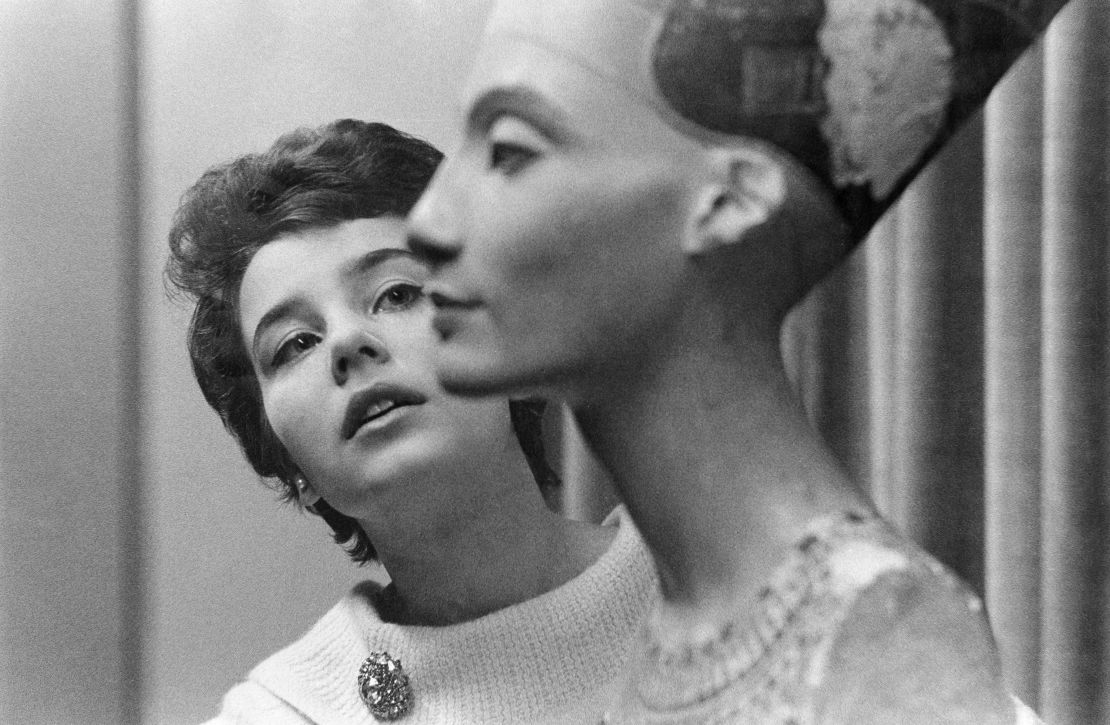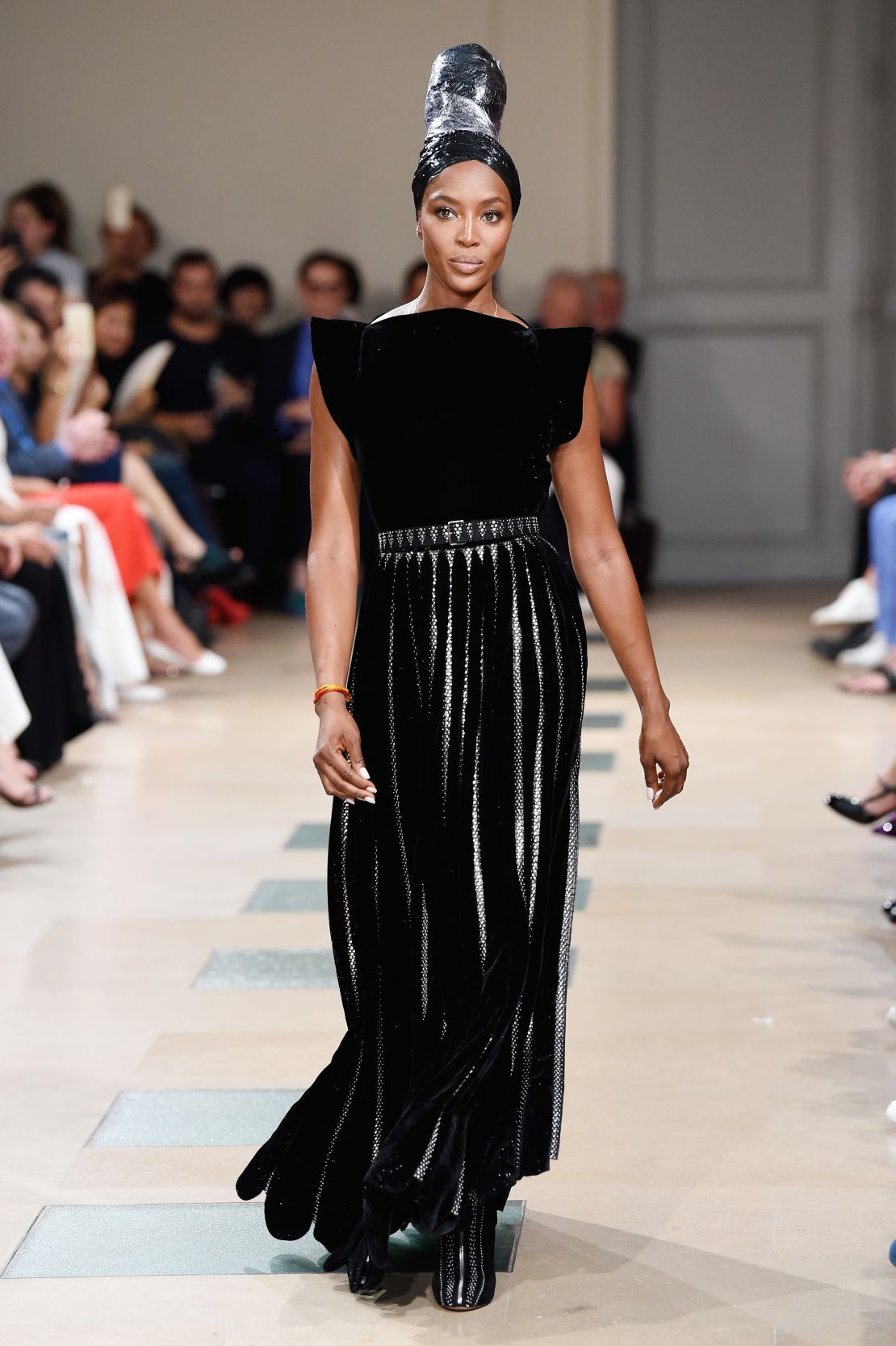The artifact’s sharply defined features — her chiseled jawline, high cheekbones, ‘swan-like’ neck, and kohl-rimmed eyes — have, for decades, served as a reference point across fashion and the arts.
In the bust, Nefertiti is seen wearing a wide collar and a flat-topped crown with a golden band and uraeus (a headdress featuring a sacred serpent), decorated in greens, yellows, browns and blues. Research indicates that she was a royal and noblewoman who reportedly bore six daughters, one of whom is said to have married Tutankhamun, but little else is known about Nefertiti’s life and origins. Egypt in the 14th century BC was not ethnically or racially homogeneous, and many scholars surmise that, based on her depictions and the region’s population, Nefertiti would be considered a woman of color in today’s terms.
“Nefertiti’s bust is so perfect; she’s so self-possessed,” Dr. Cheryl Finley, a professor of art history at Spelman College in Atlanta, told CNN. “That’s what really grabs the attention and imagination. It’s her confidence, and her gaze, of course. It’s something that attracts us all.”
Following the bust’s discovery in the 1920s, Nefertiti quickly became an “it” girl. The meaning of her name, ‘the beautiful one has arrived,’ proved particularly apt, as her face was plastered across advertisements for kohl, and her likeness appeared in beauty columns.
Designers of the time, such as the French couturier Paul Poiret, incorporated Egyptian motifs into their work. In 1945, American milliner Lilly Daché designed hats with a distinct Nefertiti flair. By 1961, Vogue had published an article exploring the world’s ongoing “fascination” with the queen. Elizabeth Taylor’s portrayal of Cleopatra in 1963 further cemented this obsession, making the “Egyptian look” a staple in fashion circles.

Nefertiti’s style continued to influence fashion decades after the bust’s discovery. In Dior’s Spring 2004 show, John Galliano showcased looks that included tall Nefertiti hats. In 2015, Christian Louboutin launched a lipstick collection that drew inspiration from the royal wife, featuring gold-and-black vials adorned with crowns. (Nefertiti likely used the natural clay earth pigment red ochre for her lips). Jewelry designers like Azza Fahmy have evoked her in their pieces, while Azzedine Alaïa’s Fall 2017 line paid tribute with black turbans, one of which was famously worn by supermodel Naomi Campbell.
In the modern day, Nefertiti’s significance as a cultural icon remains strong. On TikTok and Instagram, influencers recreate the queen’s looks in tutorials. Her likeness inspires items as varied as mass-produced T-shirts and mugs to $14,000 dresses and high-end perfumes. In the beauty industry, Black and brown-owned brands like Juvia’s Place and UOMA Beauty have marketed makeup that pays homage to Nefertiti. Even plastic surgeons name-drop her with the “Nefertiti Lift”— a non-invasive cosmetic technique that uses Botox to enhance the jawline.
“Nefertiti’s bust… transcends time,” explained Finley. “It also enables people to draw their own power from it.”
But the story of how the bust of Nefertiti found its way to Berlin in the first place is mired in controversy. After being transported to Europe in 1913, one year after its discovery in Egypt, the piece was hidden from public view for over a decade. In 1924, to much fanfare, it was put on display at the Neues Museum, where it still remains, spurring an ongoing debate about its rightful resting place (a recent petition led by Egyptologist Zahi Hawass has reignited calls for its repatriation, saying that its removal from the country was “unjustified” and against “the spirit of Egyptian laws”.)

When the bust was first unveiled, White Western women sought to emulate Nefertiti’s look. A 1933 New York Times article encouraged women to recreate her angular features — albeit without darkening the skin, echoing structural imbalances in the beauty industry, which fetishized non-European aesthetics yet discouraged and discriminated against darker skin tones. Women began to fashion their looks after Nefertiti’s style, lining their eyes like her cat-eye, wearing tops that imitated the era’s collars, and donning tall hats or styling their hair high to resemble her crown. Replicas of the bust even appeared in American hair salons, promising the allure of her ‘exotic’ beauty.
“And why wouldn’t you want to look like her?” said Dr. Elka Stevens, an associate professor of visual culture and studio art at Howard University in Washington, D.C. “Take the crown off, drop her in any society, and she can fit in. ”
Nefertiti may have been more palatable to European audiences as some of the bust’s features align well with Western aesthetic preferences, explained Professor Charmaine A. Nelson of the University of Massachusetts Amherst. The queen, she noted, defied “so much of the history of the Western perception of Black women and women of color, (which) is as ‘other,’ as ‘grotesque,’ as ‘unaesthetic body,’” said Nelson, who teaches Black diasporic art and art history. “It’s really striking and probably works in the favor of the White gaze that her hair is covered,” she added, suggesting that textured hair, particularly Afro-textured styles, have historically challenged Eurocentric beauty standards.